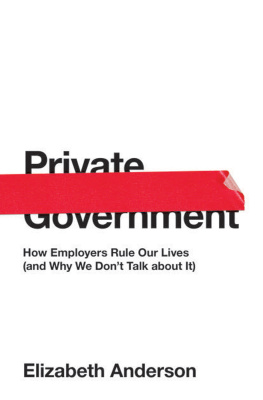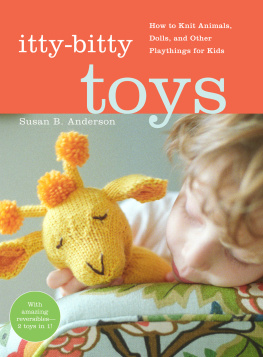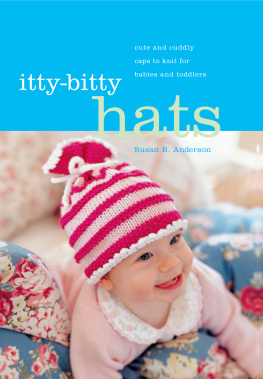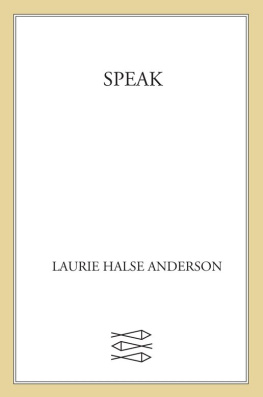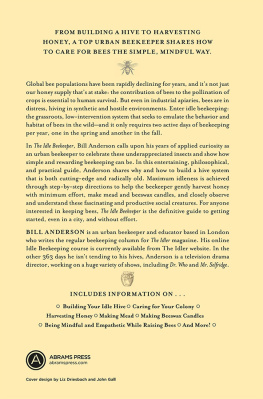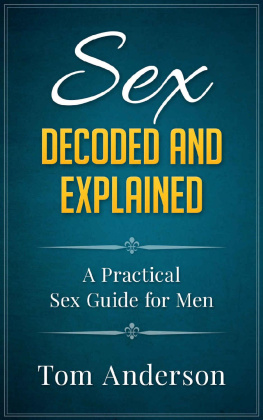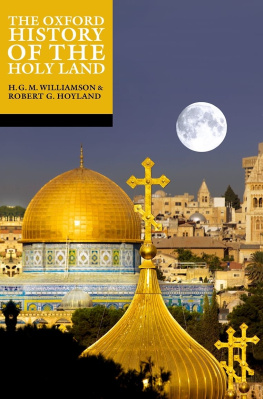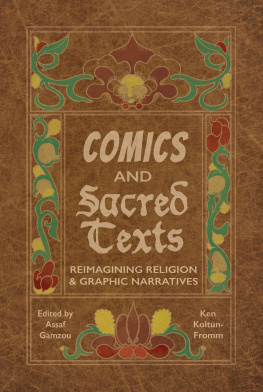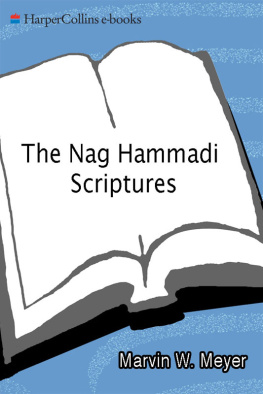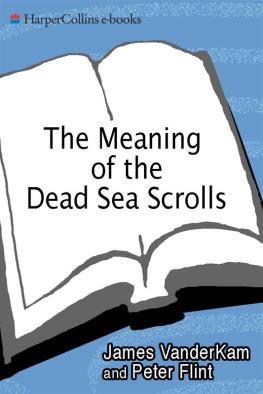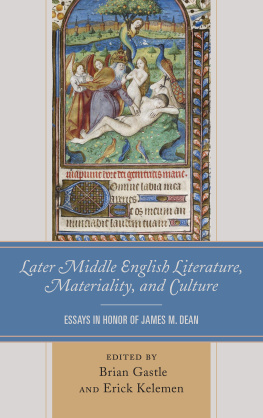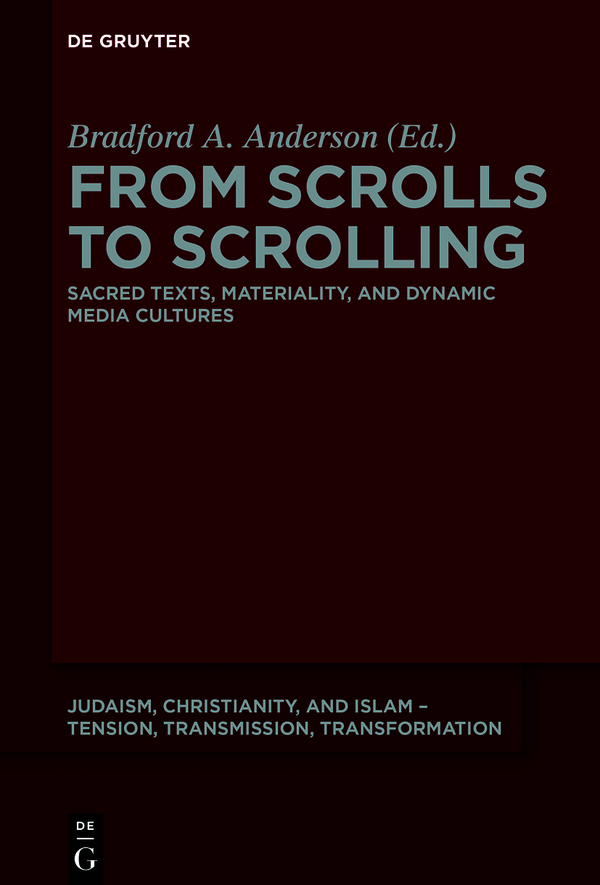Judaism, Christianity, and Islam Tension, Transmission, Transformation
Edited by
Patrice Brodeur
Alexandra Cuffel
Assaad Elias Kattan
Georges Tamer
Volume
ISBN 9783110629590
e-ISBN (PDF) 9783110634440
e-ISBN (EPUB) 9783110631463
Bibliographic information published by the Deutsche Nationalbibliothek
The Deutsche Nationalbibliothek lists this publication in the Deutsche Nationalbibliografie; detailed bibliographic data are available on the Internet at http://dnb.dnb.de.
2020 Bradford A. Anderson, published by Walter de Gruyter GmbH, Berlin/Boston
This work is licensed under the Creative Commons Attribution-NonCommercial-NoDerivatives 4.0 License.
Abbreviations
ANTF
Arbeiten zur neutestamentlichen Textforschung
AYB
Anchor Yale Bible
BETL
Bibliotheca ephemeridum theologicarum lovaniensium
BoCP
Book of Common Prayer
BZAW
Beihefte zur Zeitschrift fur die alttestamentliche Wissenschaft
BZNW
Beihefte zur Zeitschrift fur die neutestamentliche Wissenschaft
CBGM
Coherence-Based Genealogical Method
CSML
Cambridge Studies in Medieval Literature
DBS
Digital Biblical Studies
DJD
Discoveries of the Judaean Desert
DSD
Dead Sea Discoveries
ECM
editio critica maior
HOSNME
Handbook of Oriental Studies, The Near and Middle East
HThKAT
Herders Theologischer Kommentar zum Alten Testament
HTR
Harvard Theological Review
HTS
Harvard Theological Studies
JBL
Journal of Biblical Literature
JEH
Journal of Ecclesiastical History
JIM
Journal of Islamic Manuscripts
JIS
Journal of Islamic Studies
JQR
Jewish Quarterly Review
JQS
Journal of Quranic Studies
JSJS
Supplements to the Journal for the Study of Judaism
JSNT
Journal for the Study of the New Testament
KHC
Kurzer Hand-Commentar zum Alten Testament
LMB
Late Medieval Bible
LSTS
The Library of Second Temple Studies
MRAT
Medieval and Renaissance Authors and Texts
NIGTC
New International Greek Testament Commentary
NKJV
New King James Version
NovTSup
Supplements to Novum Testamentum
NTTSD
New Testament Tools, Studies, and Documents
NTS
New Testament Studies
OTE
Old Testament Essays
PSAT
Poetologische Studien zum Alten Testament
RdQ
Revue de Qumran
RSTC
Alfred W. Pollard et al., A Short-Title Catalogue of Books Printed in England, Scotland, & Ireland and of English Books Printed Abroad, 1475-1640, 2nd ed., 3 vols. (London: The Bibliographical Society, 1976)
SFIK
Schriften zur Frhen Islamgeschichte und zum Koran
StTDJ
Studies on the Texts of the Desert of Judah
TuT
M. Lembke, et al., eds. Text und Textwert der griechischen Handschriften des Neuen Testaments. VI. Die Apokalypse, ANTF 49 (Berlin: de Gruyter, 2017)
TUGAL
Texte und Untersuchungen zur Geschichte der altchristlichen Literatur
TynBulTyndale Bulletin
WBC
Word Biblical Commentaries
WUNT
Wissenschaftliche Untersuchungen zum Neuen Testament
WWMW
The Written Word: The Manuscript World
ZAC
Zeitschrift fr antikes Christentum
Preface
The origins of this volume can be traced back to a symposium held at Dublin City University on the 6th September 2017. Using the digital turn as a starting point, the symposium focused on how and why materiality should be a more significant component of our reflection on the sacred texts of Judaism, Christianity, and Islam. The symposium was part of a larger project (From Scrolls to Scrolling: Sacred Texts, Materiality, and Dynamic Media Cultures) that was funded by the Irish Research Council New Foundations Scheme, and I am immensely grateful to the Research Council for their support. This project included collaboration with colleagues from the University of Heidelberg and the Material Text Cultures research project; I offer sincere thanks to Professor Jan Christian Gertz, Dr Friederike Schcking-Jungblut, and Dr Anna Krau for the hospitality that was shown during a research visit to Heidelberg. Further financial and administrative support for the symposium came from the DCU School of Theology, Philosophy, and Music, and special thanks are due to Dr Ethna Regan, Dr Garrick Allen, and Dr Jonathan Kearney for their support and encouragement. Additional financial support for the publication of this volume was provided by the DCU Faculty of Humanities and Social Sciences, for which I am very grateful.
I want to thank all of the contributors for their fine scholarship and research, as well as their patience and collegiality during the process. Finally, I offer a special note of thanks to the JCIT editors, as well as Sophie Wagenhofer at de Gruyter, for their encouragement and support in bringing this project to publication.
Bradford A. Anderson
Dublin, Ireland
Introduction
Materiality, Liminality, and the Digital Turn: The Sacred Texts of Judaism, Christianity, and Islam in Material Perspective
Bradford A. Anderson
[Writing] is a maiden with a pen, a harlot in print.
Filippo de Strata
The above quotation comes from a fifteenth century Benedictine monk who was not particularly happy with the rise of print culture a sentiment I suspect he shared with many contemporaries. Technological developments have a long history of disrupting society and culture, and changes to how texts have been produced and transmitted through the centuries have been a large part of such developments. Indeed, from scroll to codex, from manuscript to moveable print, and from book culture to digital contexts, these changes have been monumental in shaping how people communicate.
It is not surprising that sacred texts have been at the heart of many such developments; and yet, the relationship between sacred texts and the material forms in which they are embodied is a complicated one in many traditions. The traditions of Judaism, Christianity, and Islam often describe their respective sacred texts as timeless indeed, divine messages. An implication of this timelessness is that within these traditions, focus has been placed primarily on the content of these texts, while issues of materiality have often been taken for granted. From this perspective, scrolls, books, and digital devices are simply receptacles in which the text is housed. However, such thinking masks the fact that these texts are always embodied in particular material forms, which emerge in specific times and places, and such embodiment necessarily has implications for the use and reception of these texts.
It is often during times of change that the materiality of objects becomes apparent, and we are living through such a moment. In doing so, these essays seek to resituate materiality, along with transitions between media forms, as significant for the academic study of sacred texts within and between these religious traditions.
Key Themes in the Volume
Four key areas are highlighted in this volume. First, the essays give sustained attention to the diverse ways in which materiality has impacted the production and use of sacred texts in Judaism, Christianity, and Islam down through the centuries. From antiquity, those studying the Tanakh, the Bible, and the Quran have focused their attention almost exclusively on proper understanding and interpretation of these collections. This is understandable; after all, it is the content of these writings that has most interested readers down through the centuries. As noted above, this has resulted in widespread understanding within these traditions of an abstract, disembodied message, with little thought given to the materiality of such texts. Perhaps unwittingly, these same presumptions have carried over into the academic study of these textual traditions, where the semantic dimension the content and its interpretation has received the vast majority of scholarly attention.


